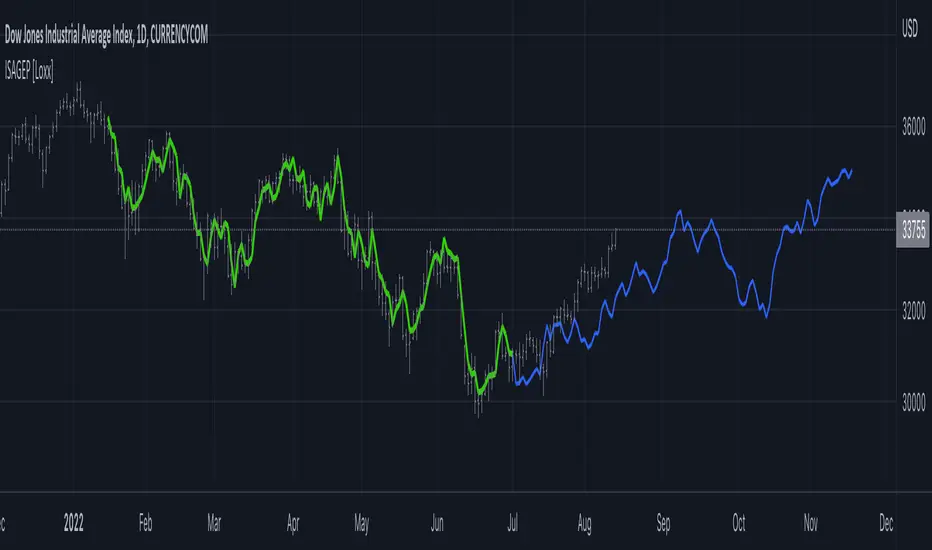OPEN-SOURCE SCRIPT
מעודכן Itakura-Saito Autoregressive Extrapolation of Price [Loxx]

Itakura-Saito Autoregressive Extrapolation of Price [Loxx] is an indicator that uses an autoregressive analysis to predict future prices. This is a linear technique that was originally derived or speech analysis algorithms.
What is Itakura-Saito Autoregressive Analysis?
The technique of linear prediction has been available for speech analysis since the late 1960s (Itakura & Saito, 1973a, 1970; Atal & Hanauer, 1971), although the basic principles were established long before this by Wiener (1947). Linear predictive coding, which is also known as autoregressive analysis, is a time-series algorithm that has applications in many fields other than speech analysis (see, e.g., Chatfield, 1989).
Itakura and Saito developed a formulation for linear prediction analysis using a lattice form for the inverse filter. The Itakura–Saito distance (or Itakura–Saito divergence) is a measure of the difference between an original spectrum and an approximation of that spectrum. Although it is not a perceptual measure it is intended to reflect perceptual (dis)similarity. It was proposed by Fumitada Itakura and Shuzo Saito in the 1960s while they were with NTT. The distance is defined as: The Itakura–Saito distance is a Bregman divergence, but is not a true metric since it is not symmetric and it does not fulfil triangle inequality.
read more: Selected Methods for Improving Synthesis Speech Quality Using Linear Predictive Coding: System Description, Coefficient Smoothing and Streak
Data inputs
Things to know
Related Indicators (linear extrapolation of price)
Levinson-Durbin Autocorrelation Extrapolation of Price
![Levinson-Durbin Autocorrelation Extrapolation of Price [Loxx]](https://s3.tradingview.com/m/mvUdLxSg_mid.png)
Weighted Burg AR Spectral Estimate Extrapolation of Price
![Weighted Burg AR Spectral Estimate Extrapolation of Price [Loxx]](https://s3.tradingview.com/g/G3VyvCoH_mid.png)
Helme-Nikias Weighted Burg AR-SE Extra. of Price [Loxx]
![Helme-Nikias Weighted Burg AR-SE Extra. of Price [Loxx]](https://s3.tradingview.com/8/8YbmmPCn_mid.png)
What is Itakura-Saito Autoregressive Analysis?
The technique of linear prediction has been available for speech analysis since the late 1960s (Itakura & Saito, 1973a, 1970; Atal & Hanauer, 1971), although the basic principles were established long before this by Wiener (1947). Linear predictive coding, which is also known as autoregressive analysis, is a time-series algorithm that has applications in many fields other than speech analysis (see, e.g., Chatfield, 1989).
Itakura and Saito developed a formulation for linear prediction analysis using a lattice form for the inverse filter. The Itakura–Saito distance (or Itakura–Saito divergence) is a measure of the difference between an original spectrum and an approximation of that spectrum. Although it is not a perceptual measure it is intended to reflect perceptual (dis)similarity. It was proposed by Fumitada Itakura and Shuzo Saito in the 1960s while they were with NTT. The distance is defined as: The Itakura–Saito distance is a Bregman divergence, but is not a true metric since it is not symmetric and it does not fulfil triangle inequality.
read more: Selected Methods for Improving Synthesis Speech Quality Using Linear Predictive Coding: System Description, Coefficient Smoothing and Streak
Data inputs
- Source Settings: -Loxx's Expanded Source Types. You typically use "open" since open has already closed on the current active bar
- LastBar - bar where to start the prediction
- PastBars - how many bars back to model
- LPOrder - order of linear prediction model; 0 to 1
- FutBars - how many bars you want to forward predict
Things to know
- Normally, a simple moving average is calculated on source data. I've expanded this to 38 different averaging methods using Loxx's Moving Avreages.
- This indicator repaints
Related Indicators (linear extrapolation of price)
Levinson-Durbin Autocorrelation Extrapolation of Price
![Levinson-Durbin Autocorrelation Extrapolation of Price [Loxx]](https://s3.tradingview.com/m/mvUdLxSg_mid.png)
Weighted Burg AR Spectral Estimate Extrapolation of Price
![Weighted Burg AR Spectral Estimate Extrapolation of Price [Loxx]](https://s3.tradingview.com/g/G3VyvCoH_mid.png)
Helme-Nikias Weighted Burg AR-SE Extra. of Price [Loxx]
![Helme-Nikias Weighted Burg AR-SE Extra. of Price [Loxx]](https://s3.tradingview.com/8/8YbmmPCn_mid.png)
הערות שחרור
Coordinate cleanupהערות שחרור
Updating drawing functions. הערות שחרור
Increased lookback range to max of 2000 bars. Future bar draws are limited to math.min(array output calcs, FutBars) settings. All settings work now. הערות שחרור
Fixed error and removed smoothing, it wasn't having the desired effect.הערות שחרור
Removed unused inputs. הערות שחרור
Updated lines calculations. סקריפט קוד פתוח
ברוח האמיתית של TradingView, יוצר הסקריפט הזה הפך אותו לקוד פתוח, כך שסוחרים יוכלו לעיין בו ולאמת את פעולתו. כל הכבוד למחבר! אמנם ניתן להשתמש בו בחינם, אך זכור כי פרסום חוזר של הקוד כפוף ל־כללי הבית שלנו.
Public Telegram Group, t.me/algxtrading_public
VIP Membership Info: patreon.com/algxtrading/membership
VIP Membership Info: patreon.com/algxtrading/membership
כתב ויתור
המידע והפרסומים אינם מיועדים להיות, ואינם מהווים, ייעוץ או המלצה פיננסית, השקעתית, מסחרית או מכל סוג אחר המסופקת או מאושרת על ידי TradingView. קרא עוד ב־תנאי השימוש.
סקריפט קוד פתוח
ברוח האמיתית של TradingView, יוצר הסקריפט הזה הפך אותו לקוד פתוח, כך שסוחרים יוכלו לעיין בו ולאמת את פעולתו. כל הכבוד למחבר! אמנם ניתן להשתמש בו בחינם, אך זכור כי פרסום חוזר של הקוד כפוף ל־כללי הבית שלנו.
Public Telegram Group, t.me/algxtrading_public
VIP Membership Info: patreon.com/algxtrading/membership
VIP Membership Info: patreon.com/algxtrading/membership
כתב ויתור
המידע והפרסומים אינם מיועדים להיות, ואינם מהווים, ייעוץ או המלצה פיננסית, השקעתית, מסחרית או מכל סוג אחר המסופקת או מאושרת על ידי TradingView. קרא עוד ב־תנאי השימוש.